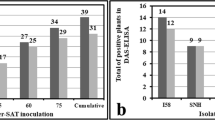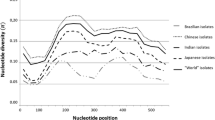Abstract
The Cowpea aphid-borne mosaic virus (CABMV) causes the most important disease in passion fruit (Passiflora spp.) in Brazil. The genetic diversity of Brazilian CABMV isolates infecting yellow passion fruit was evaluated. Leaves presenting symptoms of mosaic and blister were collected in orchards in four Brazilian states. Samples were submitted to RNA extraction, RT-PCR, sequencing and phylogenetic analyses of two regions of the CABMV genome: complete coat protein (CP) and partial cytoplasmic cylindrical inclusion (CI), representing together about 20 % of the genome. Potential alternative hosts to CABMV in areas with intensive passion fruit farming in the state of São Paulo were analyzed. Isolates did not infect cowpea (Vigna unguiculata) and common bean (Phaseolus vulgaris). Only Macroptilium atropurpureum behaved as a differential host to an isolate from the southernmost region of the state of São Paulo. In spite of the little variation in biological properties, CABMV isolates from São Paulo presented moderate genetic diversity between one another, especially between isolates from the other states, with nucleotide identity between 88 and 99 % (84 to 100 % amino acid identity) for CP and 85 % and 99 % (93 to 100 % amino acid identity) for CI. Isolates did not group consistently by origin or hosts in the maximum likelihood tree. The parent strains of CABMV isolates in São Paulo occupied a more basal position in the phylogenetic tree, suggesting the possible origin of Brazilian isolates. Recombination events were observed only for CP. Isolates from São Paulo were the major parents of CABMV recombinant strains of cowpea, passion fruit and peanut from other Brazilian states. These results agree with the expansion pattern of passion fruit cultures in the country, and suggest that the São Paulo region is the origin of CABMV in Brazil, from which isolates spread to other regions and evolved.




Similar content being viewed by others
References
Adams MJ, Antonin JF, Fauquet CM (2005) Molecular criteria for genus and species discrimination within the family potyviridae. Arch Virol 150:459–479
Adams MJ, Zerbini FM, Frecha R, Rabenstein F, Stenger DC, Valkonen JPT (2012) Potyviridae. In: King AMQ, Adams MJ, Carstens EB, Lefkowitz EJ (eds) Virus taxonomy: ninth report of the international committee on taxonomy of viruses. Elsevier Academic Press, London, pp 1069–1089
Agrianual (2013) Anuário da agricultura brasileira. Informa Economics FNP, São Paulo, p 480
Barros DR, Alfenas-Zerbini P, Beserra JEA, Antunes TFS, Zerbini FM (2011) Comparative analysis of the genomes of two isolates of Cowpea aphid-borne mosaic virus (CABMV) obtained from different hosts. Arch Virol 156:1085–1091
Bashir M, Ahmad Z, Ghafooh A (2002) Cowpea aphid-borne mosaic potyvirus: a review. Int J Pest Manag 48:155–168
Berger PH, Wyatt SD, Shiel PJ, Silbernagel MJ, Duffej K, Mink GI (1997) Phylogenetic analyses of the Potyviridae with emphasis on legume-infecting potyviruses. Arch Virol 142:1979–1999
Cerqueira-Silva CBM, Conceição LDHCS, Souza AP, Corrêa RX (2014) A history of passion fruit woodiness disease with enphasis on the current situation in Brazil and prospects for Brazilian passion fruit cultivation. Eur J Plant Pathol 139:261–270
Chagas CM, Kitajima EW, Lin MT (1981) Grave moléstia em Maracujá amarelo (Passiflora edulis f. flavicarpa Deg) no Estado da Bahia, causada por um isolado do vírus “woodiness” do maracujá. Fitopatol Bras 6:259–268
Chagas CM, Rezende JAM, Colariccio A, Piza CT Jr, Lopes LC, Ferrari JT, Belluzi BM (1992) Ocorrência do endurecimento dos frutos do maracujazeiro no Estado de são Paulo. Rev Bras Frut 14:87–190
Chen J, Chen J, Adams MJ (2001) A universal PCR primer to detect members of the Potyviridae and its use to examine the taxonomic status of several members of the family. Arch Virol 146:757–766
Chung BYW, Miller WA, Atkins JF, Firth AE (2008) An overlapping essential gene in the Potyviridae. Proc Natl Acad Sci 105:5897–5902
Damiri BV, Al-Shahwan MA, Al-Saleh OA, Amer MA (2013) Identification and characterization of Cowpea aphid-borne mosaic virus isolates in Saudi Arabia. J Plant Pathol 95:79–85
Fischer IH, Rezende JAM (2008) Disease of passionflower (Passiflora spp.). Pest Technol 2:1–19
Freitas DS, Maia IG, Arruda P, Vega J (2002) Molecular characterization and evolutionary relationship of a potyvirus infecting Crotalaria in Brazil. Arch Virol 147:411–417
Garcêz RM, Silva LA, Chaves ALR, Eiras M, Meletti LMM, Azevedo-Filho JA, Colariccio A (2011) Monitoring of the aphid fauna of vector-borne viruses in a newly introduced yellow passion-fruit crop. In: Hemipteran-Plant Interactions Symposium. Abstract number 39.
Gibbs AJ, MackenziE KJ, Gibbs MJ (2008) The potyvirus of Australia. Arch Virol 153:1411–1420
Gonçalves JS, Souza SAM (2006) Fruta da paixão: panorama econômico do maracujá no Brasil. Inf Econ 36:29–35
Ha C, Coombs S, Revill PA, Harding RM, Vu M, Dale JL (2008) Design and application of two novel degenerate primer pairs for the detection and complete genomic characterization of potyviruses. Arch Virol 153:25–36
Inoue AK, Mello RN, Nagata T, Kitajima EW (1995) Characterization of Passionfruit woodiness virus isolates from Brasília and surrounding region, Brazil. Fitopatol Bras 20:479–485
Iwai H, Yamashita Y, Nishi N, Nakamura M (2006) The Potyvirus associated with the dapple fruit of Passiflora edulis in Kagoshima prefecture, Japan is the third strain of the proposed new species East Asian Passiflora virus (EAPV) phylogenetically distinguished from strains of Passion fruit woodiness virus. Arch Virol 151:811–818
Kitajima EW, Alcantara BK, Madureira PM, Alfenas-Zerbini P, Rezende JAM, Zerbini FM (2008) A mosaic of beach bean (Canavalia rosea) caused by an isolate of Cowpea aphid-borne mosaic virus in Brazil. Arch Virol 153:743–747
López-Moya JJ, García JA (2008) Potyviruses. In: Mahy BWJ, Van Regenmortel MHV (eds) Encyclopedia of virology. Elsevier, Oxford, pp 313–322
Martin DP, Lemey P, Lott M, Moulton V, Posada D, Lefeuvre P (2010) RDP3: a flexible and fast computer program for analyzing recombination. Bioinformatics 26:2462–2463
Meletti LMM (2011) Avanços na cultura do Maracujá no Brasil. Rev Bras Frut (vol. especial):83–91.
Nascimento AVS, Souza ARR, Alfenas PF, Andrade GP, Carvalho MG, Pio-Ribeiro G, Zerbini FM (2004) Análise filogenética de potyvírus causando endurecimento dos frutos do maracujazeiro no Nordeste do Brasil. Fitopatol Bras 29:378–383
Nascimento AVS, Santana EM, Braz ASK, Alfenas PF, Pio-Ribeiro G, Andrade GP, Carvalho MG, Zerbini FM (2006) Cowpea Aphid-Borne Mosaic Virus (CABMV) is widespread in passionfruit in Brazil and causes passionfruit woodiness disease. Arch Virol 151:797–1809
Nicolini C, Rabelo Filho FAC, Resende RO, Andrade GP, Kitajima EW, Pio-Ribeiro G, Nagata T (2012) Possible host adaptation as an evolution factor of Cowpea aphid-borne mosaic virus deduced by coat protein gene analysis. J Phytopathol 160:82–87
Pio-Ribeiro G, Pappu SS, Pappu HR, Andrade GP, Reddy DVR (2000) Occurrence of Cowpea aphid-borne mosaic virus in peanut in Brazil. Plant Dis 84:760–766
Posada D, Crandal KA (1998) A model test: testing the model of DNA substitution. Bioinformatics 14:817–818
Sambrook J, Fritsch F, Maniatis T (1989) Molecular cloning, 2nd edn. Cold Spring Harbor Press, New York
Sanger F, Niclken S, Coulson AR (1977) DNA sequencing with chain terminating inhibitors. Proc Natl Acad Sci 74:5463–5467
Silva LA, Garcêz RM, Chaves ALR, Colariccio A, Eiras M (2012) Transmissão experimental revela novos potenciais reservatórios do Cowpea aphid-borne mosaic virus. Summa Phytopathol 38:168–169
Souto ER, Kitajima EW (1991) Propriedades biológicas de um Potyvirus isolado de “lava-pratos” (Cassia hoffmannseggii) procedente de Pernambuco. Fitopatol Bras 16:256–259
Souto ER, Kitajima EW (1992) Purificação do vírus das manchas amarelas da Cassia, eletroforese de proteínas e sorologia. Fitopatol Bras 24:1596–1599
Wylie SJ, Jones MGK (2011) The complete genome sequence of a Passion fruit woodiness virus isolate from Australia determined using deep sequencing, and its relationship to other potyvirus. Arch Virol 156:479–482
Acknowledgments
This work was supported by a scientific research project given by FAPESP (proc. 2011/11796-5). ME is supported by a CNPq research fellowship (proc. 302018/2011-5). L.K.R. and R.M.G. were funded by CAPES scholarships; L.A.S. was funded by FAPESP scholarship (proc. 2010/02679-2). We thank Dr. J.A.M. Rezende (ESALQ, Universidade de São Paulo, Brazil) and Dr. F.M. Zerbini (Universidade Federal de Viçosa, Brazil) for kindly providing antiserum against CABMV, Dr. M. Moura Rocha (Embrapa Meio-Norte, Brazil) for cowpea seeds, and Mr. Félix Nonnenmacher for the English version and critical review of the manuscript.
Author information
Authors and Affiliations
Corresponding author
Rights and permissions
About this article
Cite this article
Rodrigues, L.K., Silva, L.A., Garcêz, R.M. et al. Phylogeny and recombination analysis of Brazilian yellow passion fruit isolates of Cowpea aphid-borne mosaic virus: origin and relationship with hosts. Australasian Plant Pathol. 44, 31–41 (2015). https://doi.org/10.1007/s13313-014-0308-5
Received:
Accepted:
Published:
Issue Date:
DOI: https://doi.org/10.1007/s13313-014-0308-5




